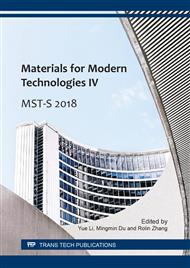[1]
S. G. Kumar, K. S. Rao. Polymorphic phase transition among the titania crystal structures using a solution-based approach: from precursor chemistry to nucleation process, J. Nanoscale, 2014, 6(20):11574-632.
DOI: 10.1039/c4nr01657b
Google Scholar
[2]
B. O'Regan, M. A. Grätzel. Low-cost, high-efficiency solar cell based on dye-sensitized colloidal TiO2 films, J. Nature, 1991, 353(6346): 737-740.
DOI: 10.1038/353737a0
Google Scholar
[3]
Y. L. Liu, D. D. Wang, J. Ni, et al. Ordered RTiO2@ATiO2 architecture for dye-sensitized solar cell applications, J. Rsc Advances, 2016, 6.
Google Scholar
[4]
B. K. Mutuma, G. N. Shao, W. D. Kim, et al. Sol-gel synthesis of mesoporous anatase-brookite and anatase-brookite-rutile TiO2 nanoparticles and their photocatalytic properties, J. J Colloid Interface Sci, 2015, 442: 1-7.
DOI: 10.1016/j.jcis.2014.11.060
Google Scholar
[5]
A. E. Shalan, M. M. Rashad, Y. Yu, et al. Controlling the microstructure and properties of titania nanopowders for high efficiency dye sensitized solar cells, J. Electrochimica Acta, 2013, 89(1):469-478.
DOI: 10.1016/j.electacta.2012.11.091
Google Scholar
[6]
L. Cano-Casanova, A. Amorós-Pérez, M. Ouzzine, et al. One step hydrothermal synthesis of TiO2, with variable HCl concentration: Detailed characterization and photocatalytic activity in propene oxidation, J. Applied Catalysis B Environmental, (2017).
DOI: 10.1016/j.apcatb.2017.08.060
Google Scholar
[7]
J. Yu, J. C. Yu et al., Effects of acidic and basic hydrolysis catalysts on the photocatalytic activity and microstructures of bimodal mesoporous titania, J. Journal of Catalysis, 217 (2003) 69-78.
DOI: 10.1016/s0021-9517(03)00034-4
Google Scholar
[8]
D. Li, X. Cheng, X. Yu, Z. Xing, Preparation and characterization of TiO2 –based nanosheets for photocatalytic degradation of acetylsalicylic acid: Influence of calcination temperature, J. Chemical Engineering Journal, 279 (2015) 994-1003.
DOI: 10.1016/j.cej.2015.05.102
Google Scholar
[9]
Sahil S, Bhaskar R S, Murty B S. Influence of process parameters on the synthesis of nano-titania by sol–gel route, J. Materials Science & Engineering A, 2007, 452:758-762.
DOI: 10.1016/j.msea.2006.11.005
Google Scholar
[10]
S. V. Umale, S. N. Tambat, V. Sudhakar, et al. Fabrication, characterization and comparison of DSSC using anatase TiO2 synthesized by various methods, J. Advanced Powder Technology, (2017).
DOI: 10.1016/j.apt.2017.08.012
Google Scholar
[11]
D. Ulrike. The surface science of titanium dioxide, J. Surface Science Report, 2003, (5): 64-66.
Google Scholar
[12]
R. R. Bacsa, J. Kiwi. Effect of rutile phase on the photocatalytic properties of nanocrystalline titania during the degradation of p-coumaric acid, J. Applied Catalysis B Environmental, 1998, 16(1):19-29.
DOI: 10.1016/s0926-3373(97)00058-1
Google Scholar


